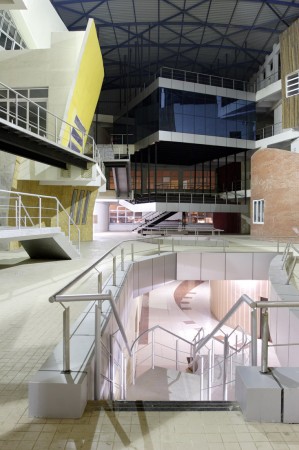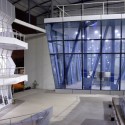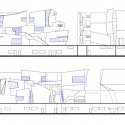Vidyalankar Institute of technology / Planet 3 Studios Architecture

Architects: Planet 3 Studios Architecture
Location: Wadala, Mumbai, India
Client: The Vidyalankar educational trust, Wadala-MumbaiDesign Team: Kalhan Mattoo, Santha Gour Mattoo, assisted by Jainish JaniStructural Consultant: S.N. Bhobe & AssociatesContractor: Nagarjuna ConstructionsService Consultant: Sunil ServicesConstruction Year: 8,826 sqmProject Year: 2004-2006Photographs: Mrigank Sharma – IndiaSutra
Location: Wadala, Mumbai, India
Client: The Vidyalankar educational trust, Wadala-MumbaiDesign Team: Kalhan Mattoo, Santha Gour Mattoo, assisted by Jainish JaniStructural Consultant: S.N. Bhobe & AssociatesContractor: Nagarjuna ConstructionsService Consultant: Sunil ServicesConstruction Year: 8,826 sqmProject Year: 2004-2006Photographs: Mrigank Sharma – IndiaSutra
Breaking new ground with radical re-think of campus architecture in India, this engineering college is devised as a contemporary 'educational village' consisting of distinct faculty blocks connected by an interior promenade with spaces for student learning activities. Protected from the elements with an oversized roof and a porous skin, the building is uses natural light and ventilation to conserve energy.
Design Program and Solution:
This project needed ability to engage a complex design program in an urban, developing country context. The challenge was in articulating the requirements of four distinct engineering faculties within the same building and establishing network accesses to shared amenities. The design had to be simple and intuitive, of equitable use, have flexibility, involve low physical effort, work within context and constraint, communicate ideas visually, be experimentally satisfying, conform to restrictive building codes, demonstrate environmental sensitivity and importantly, to enable future-forward learning concepts.
Eschewing monumental verticality, we chose instead to experiment with horizontal urbanism and hit on the idea of an 'Educational Village' built within a container. This literal minded village has various groupings of similar requirements in clearly definable structures with a main 'Learning Street' as the central organizing device as well as hospitable site for spontaneous student interactions. This complex of open public spaces, enclosed semi public spaces and private areas has the spatial connectivity of open plan interiors encouraging egalitarian, communal learning experience. Each programming requirement such as administration, library, several engineering faculties, canteen etc. are individual blocks situated on either side of the inner street. Each such block functions as a self contained facility with its own faculty, library, learning spaces and connected at various levels with adjacent structures. This street at six feet above ground level sits on a basement containing laboratories, a shared resource between different faculty blocks. Staircases in cutouts on the street lead to the basement below. The building container opens with forty foot wide main entrance and a smaller subsidiary opening to the road outside with no barriers for unrestricted entry.
On the street, helpful signage guide you to your destination with the ease of intuitive logic. We have maintained the intimacy of the human scale and provided numerous activities to promote interaction. Tucked in the alcoves between the blocks, a man sized chess-board, a table tennis court, half a basketball court, a street side café with the canteen block, couple of phone-booths, a book kiosk and a graffiti wall, student work display areas, and a suspended amphitheatre. The act of appropriation of these public spaces by the students becomes a source of cultural energy.
Clusters of classrooms with student interaction zones tucked in-between function as 'Learning Suites'. Each asymmetrical classroom provides the opportunity to introduce soft seating, teaming zones. Many classrooms have 'Spill-out Balconies' that open into the inner street. Wherever required, flexibility to combine two classrooms to form one large space has been provided. Each such learning space has two side windows for natural light and ventilation.
An oversized roof, raised fourteen feet above terrace level shields the inside from inclement weather, while allowing hot air to escape from the sides. The building's public face is a deceptively quiet, porous polycarbonate skin evoking the metaphor of its industrial neighborhood. The skin is engineered to ease glare and yet allow the building to be naturally aerated.
We designed a visually kinesthetic experience of walking through asymmetric spaces, an escape from orthogonal rigidity. Use of recycled materials such as packing material obtained from shipping containers and reengineered sleeper wood from railway tracks in raw form intensify the sense of space.
We hope this design to be an assertion of the fact that powerful design can affect human psyche and duly contribute to building a great institution. This significant physical artifact will challenge future campus architecture in India.
- floor plan
- internal elevations
- concrete warp details
- external elevation
Dr. EMAD H. ISMAEEL
University of Mosul
Mosul - Iraq
Web Site: http://sites.google.com/site/emadhanee/
Tel : +964 (0)770 164 93 74
















تعليقات
إرسال تعليق